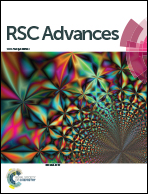Structures and luminescence properties of diethyldithiocarbamate-bridged polynuclear gold(i) cluster complexes with diphosphine/triphosphine†
Abstract
A series of polynuclear gold(I) complexes with bridging diethyldithiocarbamate (Et2dtc) and diphosphine/triphosphine were synthesized, including [{Au2(μ-dpb)(μ-Et2dtc)}SbF6]n (1, dpb = 1,4-bis(diphenylphosphino)benzene), [Au2(μ-dpb)(Et2dtc)2] (2), [Au4(μ-dpn)(μ-Et2dtc)3](SbF6) (3, dpn = 1,4-bis(diphenylphosphino)naphthalene), [Au4(μ-dpn)(μ-Et2dtc)3][Au(Et2dtc)2](SbF6)2 (4), [Au4(μ-dpa)(Et2dtc)3](SbF6) (5, dpa = 9,10-bis(diphenylphosphino)anthracene) and [{Au6(dpep)2(Et2dtc)3}{(SbF6)3}]n (6, dpep = bis(2-diphenylphosphinoethyl)phenylphosphine). The structures of 3·CH2Cl2, 4·2CH2Cl2, 5·2CH2Cl2·H2O and 6 were characterized by X-ray crystallography. The intramolecular Au⋯Au distances across bridging Et2dtc are 2.9376(7)–2.9725(8) Å in 3·CH2Cl2, 2.9762(16)–3.1078(14) Å in 4·2CH2Cl2, 2.9288(9)–3.0514(10) Å in 5·2CH2Cl2·H2O, and 2.9236(12)–3.1914(17) Å in 6, implying significant aurophilic interactions. These gold(I) complexes exhibit intense photoluminescence properties in solid state. Upon lowering the temperature from 298 to 77 K, complexes 5 and 6 exhibit an obvious red-shift from 536 nm to 589 nm for 5 and from 538 nm to 564 nm for 6, implying significant luminescence thermochromism due to thermal contraction upon cooling.


 Please wait while we load your content...
Please wait while we load your content...